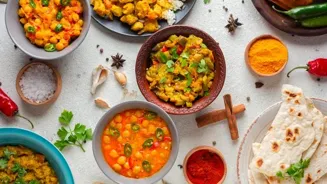Unveiling India's Diverse Cooking Styles: The Influence of Regional Ingredients. Explore how unique flavors reflect cultural heritage
India, a land famed for its vibrant culture and traditions, boasts a culinary
landscape as diverse as its geography.
From the snow-capped Himalayas to the sun-kissed beaches of the south, the country's regional ingredients play a pivotal role in shaping the unique cooking styles found in every corner.
It's not just about what's available, but how these ingredients are used that truly defines the essence of Indian cuisine. The fertile plains of Punjab offer wheat and dairy, while the coastal regions of Kerala are abundant with coconuts and spices.
This natural distribution dictates the core elements of each region's culinary identity. These readily available ingredients form the base, influencing the flavors, textures, and overall character of the dishes.
The influence extends beyond primary components; even secondary ingredients like herbs and seasonings adapt to regional variations.
Northern states' culinary richness: wheat, dairy, veggies, simple spices
The northern states, particularly Punjab and Uttar Pradesh, showcase a cooking style rooted in the land's abundance. Wheat, being a staple crop, finds its way into various forms like rotis, parathas, and naans.
The use of dairy is equally prominent, with ghee, yogurt, and paneer enriching dishes with creamy textures and subtle flavors. Simple spices like cumin, coriander, and turmeric are the mainstays, complementing the rich base ingredients.
Seasonal vegetables like spinach, mustard greens, and potatoes are incorporated into dishes, creating wholesome and satisfying meals. This culinary landscape reflects the agricultural prosperity of the region.
The abundance of fresh produce and dairy naturally leads to hearty and flavorful dishes, focusing on simple but robust flavors. The emphasis is on everyday meals that are nourishing and comforting.
Culinary transformation in East India with rice, fish, mustard seeds, and unique flavors
Moving eastward to West Bengal and Assam, the culinary scene transforms, influenced by rivers and fertile deltas. Rice, a primary crop, becomes the cornerstone meal. Fish and lentils are other components. Flavors are distinct, due to mustard and poppy seeds which are common.
The use of mustard oil provides a unique pungent taste to the food. Sweets, such as rasgulla and sandesh, are an integral part of the cuisine. The culture reflects availability of resources, the river deltas, and the love for simple yet delicious meals.
The dishes prepared speak volumes about the region.
Western Indian cuisine adapts to arid climate, using local ingredients creatively
In the western states of Gujarat and Rajasthan, the arid climate plays a key role. Ingredients like millets, lentils, and dried vegetables become dietary staples. Gujarati cuisine is famously vegetarian and known for its sweet and savoury combinations.
Dishes like dhokla, thepla, and undhiyu are all popular. Rajasthani cuisine is known for its use of spices and the techniques used to preserve food. The famous dal-baati-churma, showcases the use of lentils and wheat. Use of buttermilk and yogurt gives a cooling effect.
These adaptions of regional food due to weather is evident. The innovation in cooking gives delicious dishes despite aridity.
South Indian states' cuisines showcase diverse ingredients and history
The southern states of Tamil Nadu, Kerala, Karnataka, and Andhra Pradesh use rice, coconuts, and a variety of spices. Kerala cuisine is known for its use of coconut milk and spices like cardamom, cloves, and cinnamon. Dishes like appam, puttu, and seafood preparations highlight the region.
Tamil Nadu's cuisine emphasizes the use of tamarind and lentils, creating tangy and flavorful sambhar and rasam. Karnataka uses lentils, vegetables, and rice, which is shown in bisibele bath and masala dosa. Andhra Pradesh is characterized by spicy flavors using red chilies.
The South Indian cuisines reflect the diverse ingredients found and the history within that region.
Regional ingredients shape India's culinary identity and traditions, embodying cultural significance
The impact of regional ingredients extends beyond taste; it also provides deep cultural and historical significance. Recipes are passed down through generations, which represents the deep understanding each region cherishes. These recipes also highlight the community traditions.
Using local produce also promotes sustainability, which makes each region unique. The influence of ingredients shapes the identity and culinary traditions of India.
AI Generated Content. Glance/InMobi shall have no liability for the content